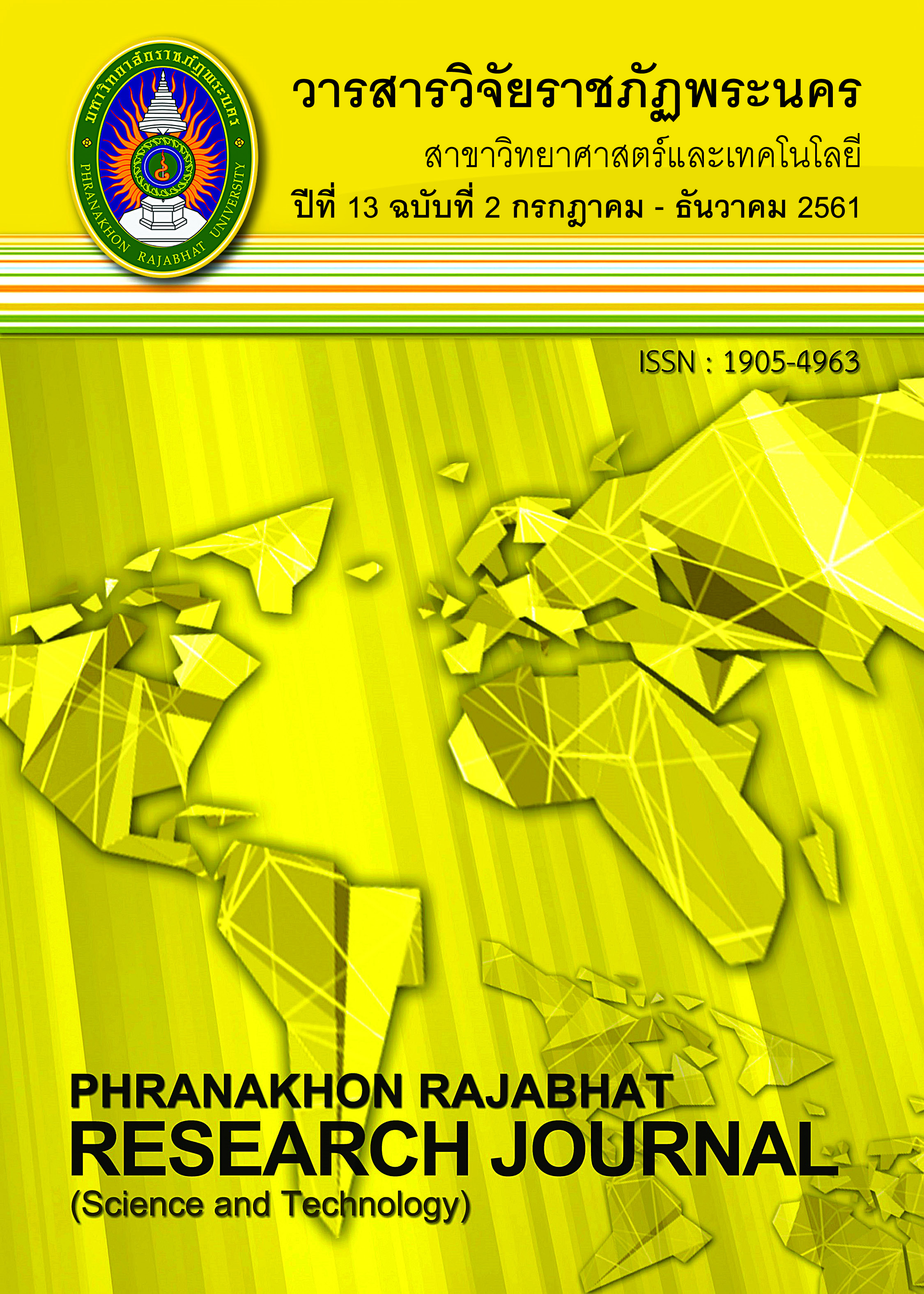การสังเคราะห์คอลลอยด์ของอนุภาคนาโนโลหะคู่ที่มีอนุภาคโลหะเงินเป็นแกนกลางและโลหะทองเป็นเปลือกหุ้มด้วยวิธีที่เป็นมิตรกับสิ่งแวดล้อมสำหรับตรวจวัดปริมาณไซยาไนด์แบบเปรียบเทียบสี
คำสำคัญ:
อนุภาคนาโนโลหะคู่ที่มีอนุภาคโลหะเงินเป็นแกนกลางและโลหะทองเป็นเปลือกหุ้ม ไซยาไนด์, การสังเคราะห์สีเขียว, การตรวจวัดแบบเปรียบเทียบสีบทคัดย่อ
มันสำปะหลังเป็นหนึ่งในพืชเศรษฐกิจที่สำคัญอย่างยิ่งของประเทศไทย โดยส่วนที่นิยมนำมาใช้หรือบริโภค คือ หัวมันสำปะหลังซึ่งเป็นรากที่โตขึ้นจากการสะสมอาหารในรูปของคาร์โบไฮเดรตหรือแป้ง อย่างไรก็ตามในหัวมันสำปะหลังมีสารประกอบไซยาโนจินิกไกลโคไซด์ซึ่งจะสลายตัวเป็นกรดไฮโดรไซยานิคหรือไซยาไนด์ที่เป็นพิษ ในงานวิจัยนี้ผู้วิจัยจึงได้เสนอวิธีการตรวจวัดปริมาณไซยาไนด์ในมันสำปะหลังแบบรวดเร็ว ง่าย และมีความไวสูง โดยใช้คอลลอยด์อนุภาคนาโนโลหะคู่ที่มีอนุภาคโลหะเงินเป็นแกนกลางและโลหะทองเป็นเปลือกหุ้ม (Ag@Au core-shell NPs) สำหรับตรวจวัดปริมาณไซยาไนด์ในมันสำปะหลังด้วยวิธีการเปรียบเทียบสี โดยคอลลอยด์ของ Ag@Au core-shell NPs ที่สังเคราะห์ขึ้นด้วยวิธีที่เป็นมิตรกับสิ่งแวดล้อมจะมีสีม่วง อนุภาคที่ได้มีรูปร่างเป็นทรงกลมที่มีขนาดเส้นผ่านศูนย์กลางประมาณ 22 nm เมื่อนำ Ag@Au core-shell NPs ที่สังเคราะห์ได้ไปใช้ในการตรวจวัดปริมาณไซยาไนด์ในสารละลาย สีของคอลลอยด์ Ag@Au core-shell NPs จะเปลี่ยนสีจากสีม่วง เป็นสีส้ม สีเหลือง และกลายเป็นสารละลายใสไม่มีสี เมื่อความเข้มข้นของไซยาไนด์เพิ่มขึ้น โดยมีช่วงในการตรวจวัดความเข้มข้นของไซยาไนด์ตั้งแต่ 0-0.8 mM ใช้เวลาในการตรวจวัด 5 นาที ซึ่งเป็นวิธีการตรวจวัดที่สะดวก รวดเร็ว และมีความเป็นพิษน้อยกว่าวิธีที่ใช้อยู่ในปัจจุบัน เหมาะสมที่จะนำไปใช้ในการตรวจปริมาณไซยาไนด์ในมันสำปะหลังเพื่อการส่งออกและการจำแนกพันธุ์มันสำปะหลังที่แบ่งออกเป็นพันธุ์หวานและพันธุ์ขมได้
เอกสารอ้างอิง
Limsila, J., Limsila, A., Jaroenrat, S., Kathong, S., Tongklum, A., Wongkobrat, A., Junkhum, J., Sethasuk, J., Narintaraporn, P. & Thongsri, S. (2004). Cassava. 1st Edition. Bangkok: Idea Square Limited Partnership. (in Thai)
Panigrahi, S., Kundu, S., Ghosh, S.K., Nath, S. & Pal. T. (2005). Sugar assisted evolution of mono- and bimetallic nanoparticles. Colloids and Surfaces A: Physicochemical and Engineering Aspects. 264(1-3), 133-138.
Phetsahai, A., Thamaphat, K. & Nuntawong, N. (2016). Green synthesis of colloidal silver nanoparticles for surface-enhanced Raman scattering. Phranakhon Rajabhat Research Journal (Science and Technology). 11(1), 116-127. (in thai)
Piyachomkwan, K., Wanlapatit, S., Chotineeranat, S. & Sriroth, K. (2005). Transformation and balance of cyanogenic compounds in the cassava starch manufacturing process. Starch/Stärke. 57(2), 71-78.
Rojanaritphichet, J. (1989). Plant culture, processing industry and utilization of cassava. 1st Edition. Bangkok: Department of Agronomy, Faculty of Agriculture, Kasetsart University. (in Thai)
Sharma, V.K., Yngard, R.A. & Lin, Y. (2009). Silver nanoparticles: Green synthesis and their antimicrobial activities. Advances in Colloid and Interface Science. 145(1-2), 83-96.
Smith, E. & Dent, G. (2005). Modern Raman spectroscopy - A practical approach. West Sussex: John Wiley & Sons.
Thai Tapioca Starch Association (2017). Exporting tapioca product. Retrieved April 2, 2017, from https://www.thaitapiocastarch.org/th/information/statistics/export_tapioca_products (in thai)
Williams, I. (2001). Environmental chemistry: a modular approach. Chichester: John Wiley & Sons.
Zeng, J.B., Cao, Y.Y., Chen, J.J., Wang, X.D., Yu, J.F., Yu, B.B., Yan, Z.F. & Chen, X. (2014). Au@Ag core/shell nanoparticles as colorimetric probes for cyanide sensing. Nanoscale. 6(17), 9939-9943.
ดาวน์โหลด
เผยแพร่แล้ว
ฉบับ
ประเภทบทความ
สัญญาอนุญาต
โปรดกรอกเอกสารและลงนาม "หนังสือรับรองให้ตีพิมพ์บทความในวารสารวิจัยมหาวิทยาลัยราชภัฏพระนคร สาขาวิทยาศาสตร์และเทคโนโลยี" ก่อนการตีพิมพ์




